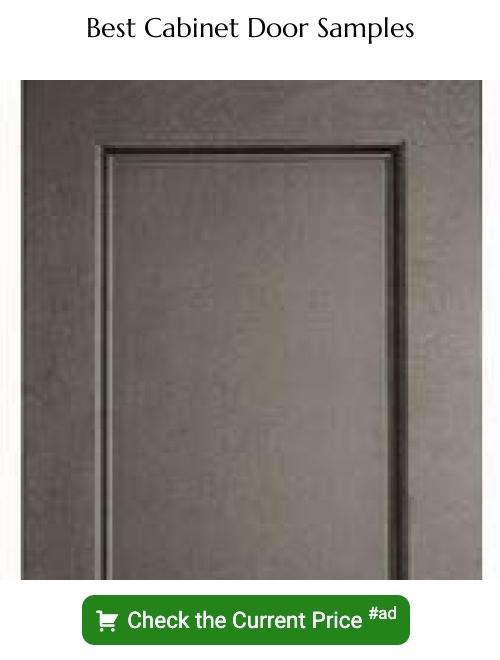Last updated on
Discover the art of seamlessly blending new cabinets with your existing kitchen setup by following our comprehensive guide on matching kitchen cabinets perfectly.
Have you ever walked into a kitchen and felt like something was off, but couldn’t quite put your finger on it? Chances are, it’s because the cabinets don’t match. Matching existing kitchen cabinets can be a daunting task, especially if they’re outdated or no longer available for purchase.
But fear not! With a little bit of creativity and some careful planning, you can seamlessly blend new additions with your existing cabinetry to create a cohesive look that will leave your guests wondering if you’ve done a complete kitchen renovation. In this article, we’ll share some tips and tricks on how to match existing kitchen cabinets so that you can achieve the perfect balance between old and new.
Key takeaways:
- Assess the condition, style, and dimensions of existing cabinets.
- Identify cabinet materials and consider veneer matching.
- Determine cabinet style and consider the overall design scheme.
- Analyze the cabinet finish and consider refinishing or matching colors.
- Measure cabinet dimensions and ensure accurate fit with new additions.
What's Inside
Assessing Your Existing Cabinets
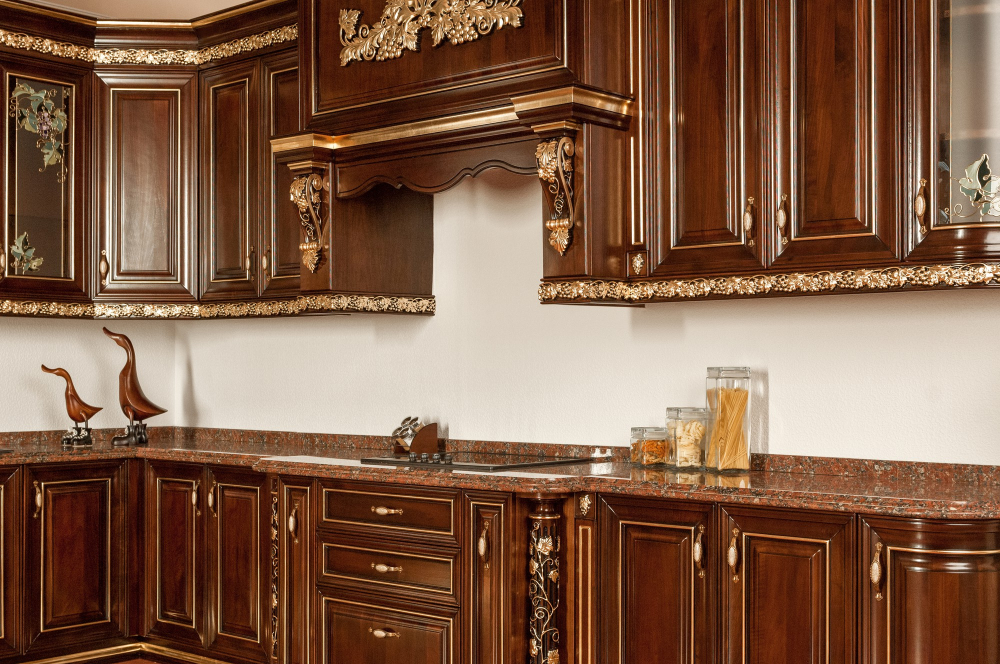
Before you start matching your existing kitchen cabinets, it’s important to assess their condition. Take a close look at each cabinet and note any damage or wear and tear that may affect the overall appearance of your kitchen.
If there are any major issues, such as water damage or warping, you may need to consider replacing those cabinets entirely.
Next, take note of the style and materials used in your current cabinetry. Are they traditional or modern? Are they made from wood veneer or solid wood? Knowing these details will help you determine what type of new cabinets will best match with them.
Measure the dimensions of each cabinet so that you can accurately compare them with potential replacements. This step is crucial for ensuring a seamless fit between old and new cabinetry.
Identifying Cabinet Materials
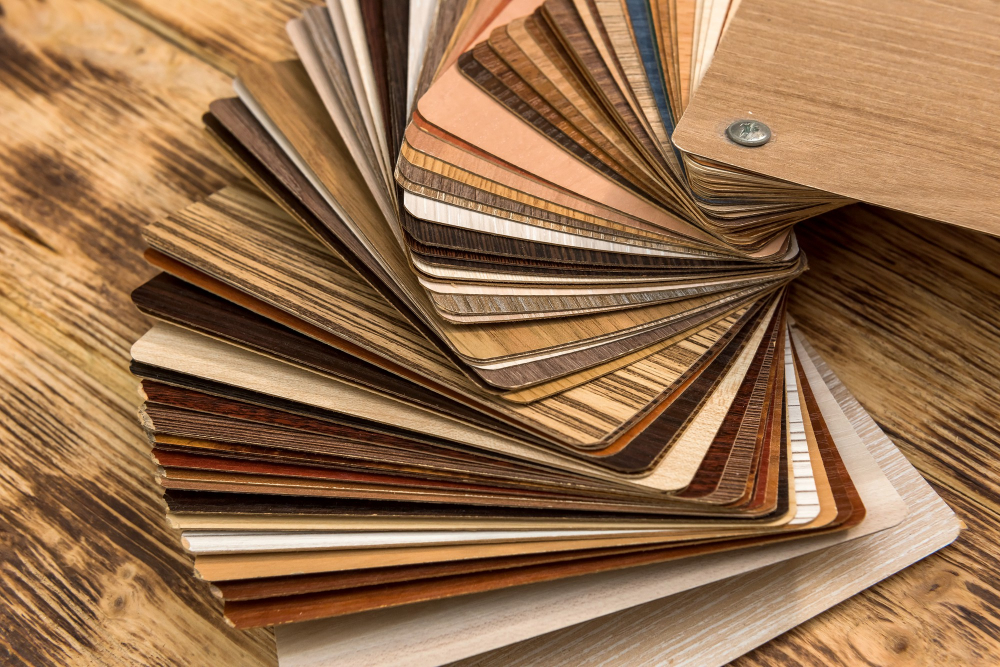
This will help you determine what type of wood, finish, and hardware to look for when selecting new cabinets. If your existing cabinetry is made from solid wood, it’s important to note the species as well as any unique characteristics such as grain patterns or knots.
If your cabinets are not made from solid wood but rather a composite material like MDF or particleboard with a veneer overlay, you’ll need to take extra care when selecting new pieces. Look for veneers that match the color and texture of your existing cabinetry.
In some cases, identifying cabinet materials may require professional assistance if you’re unsure about what type of material was used during installation. A skilled contractor can help assess the composition of your current cabinetry so that you can make informed decisions about how best to match them with new additions.
Determining Cabinet Style
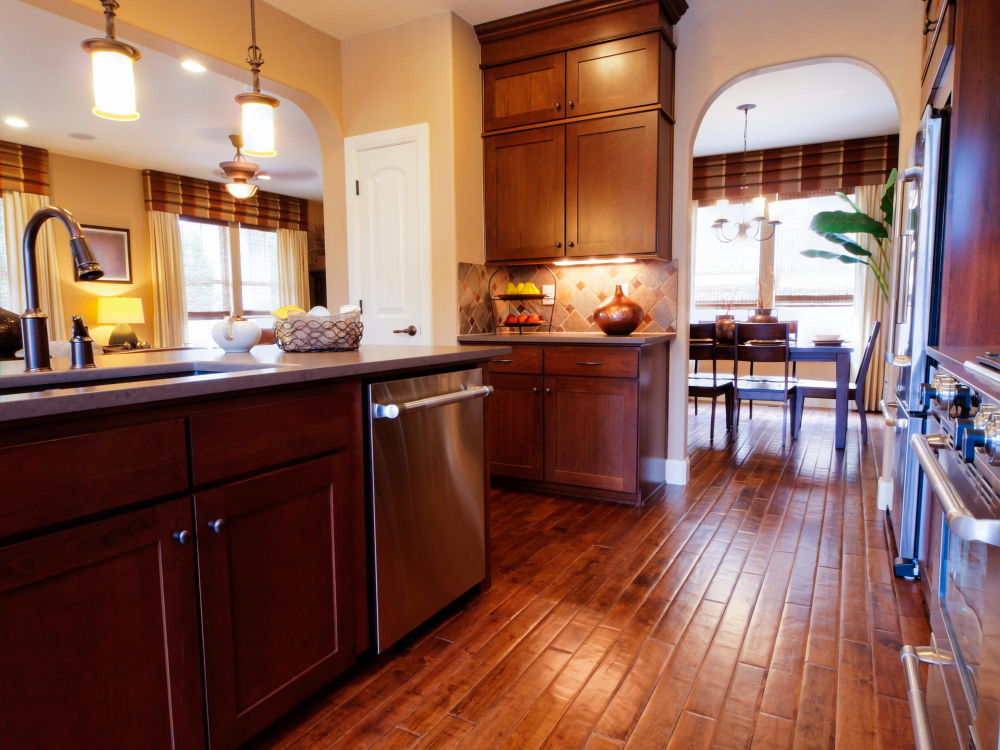
This will help you choose new cabinets that complement your current setup and create a cohesive look. Take note of the cabinet door design, as well as any decorative elements such as mouldings or trim work.
If your existing cabinets have a traditional style with raised panel doors and ornate details, it’s best to stick with this theme when choosing new cabinetry. On the other hand, if you have modern flat-panel doors without much embellishment, opt for sleek and simple designs that match this aesthetic.
It’s also essential to consider how your cabinet style fits into the overall design scheme of your kitchen. If you’re going for a farmhouse-style look but currently have contemporary cabinetry in place, it may be time to switch things up entirely rather than trying to force an awkward blend between two opposing styles.
Analyzing the Finish
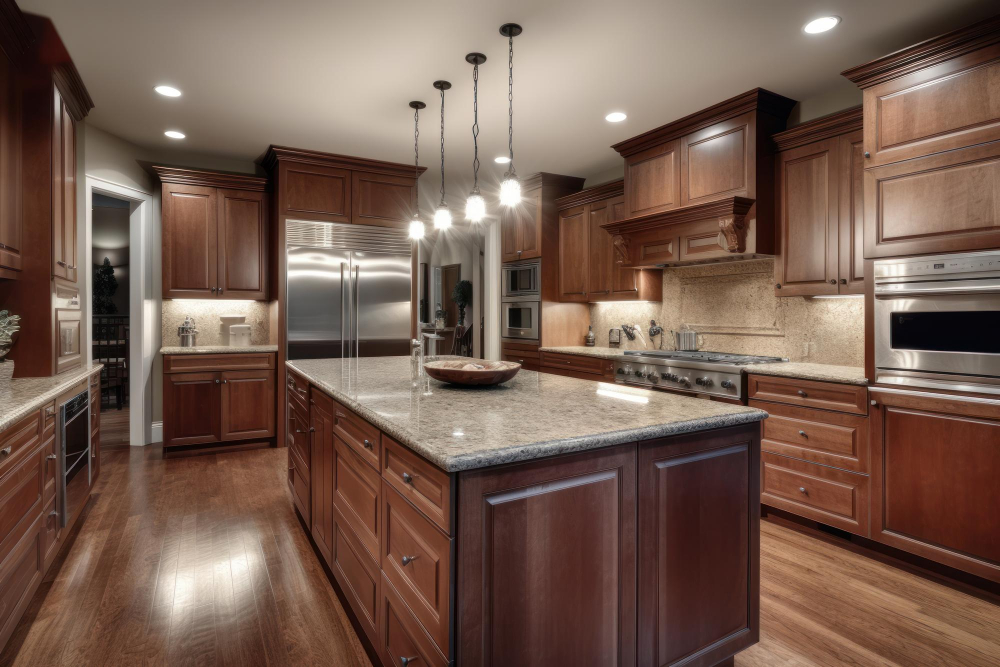
Over time, finishes can fade or change color due to exposure to sunlight, moisture, and other environmental factors. To ensure a seamless match between old and new cabinets, it’s crucial that you analyze your existing cabinet finish before making any decisions.
Start by examining your current cabinetry for any signs of wear or damage such as scratches or discoloration. Take note of the type of finish used on your cabinets – whether it’s painted or stained – as well as its sheen level (matte vs glossy).
This will help you determine what kind of paint/stain/finish you’ll need for new additions.
If possible, try taking a sample piece from one of your existing cabinet doors/drawers with you when shopping for new materials so that suppliers can better match colors and finishes. Keep in mind that even if two pieces look identical under store lighting conditions they may appear different once installed in natural light at home.
Measuring Cabinet Dimensions
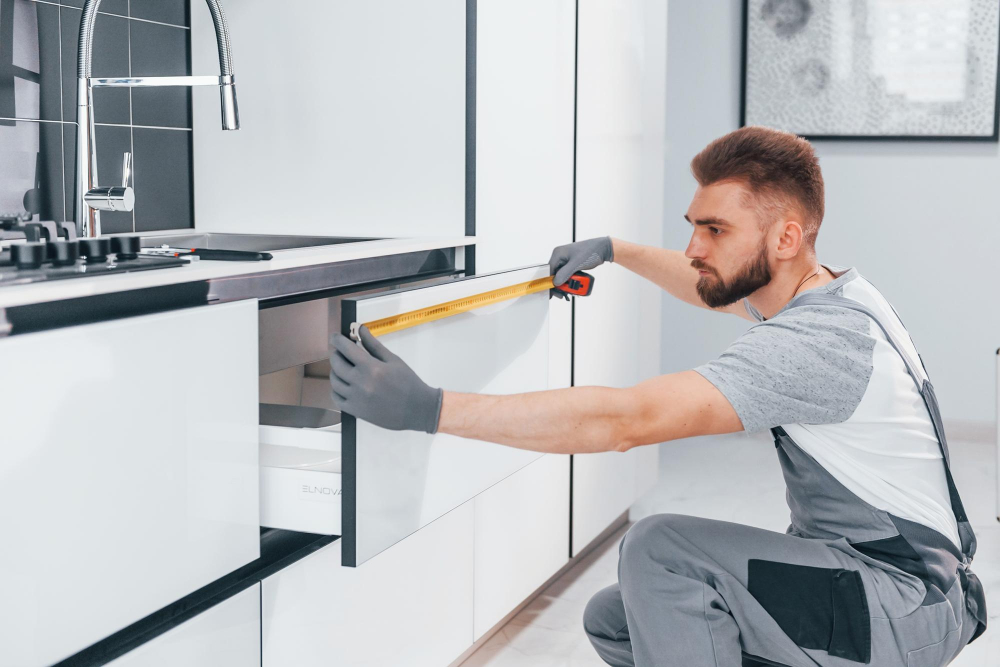
Measuring cabinet dimensions is crucial for ensuring that any new additions match the height, width, and depth of your existing cabinetry. Start by measuring the height of each cabinet from top to bottom.
Then measure the width from left to right across the face frame or door opening.
Next up is measuring depth – this can be a bit tricky as some cabinets have different depths at various points due to molding or other design elements. Measure both sides of each cabinet box (left side and right side) as well as its center point.
It’s important not only to take accurate measurements but also note them down in an organized manner so that you can refer back later when selecting new cabinets or working with a contractor on installation plans.
Noting Cabinet Hardware
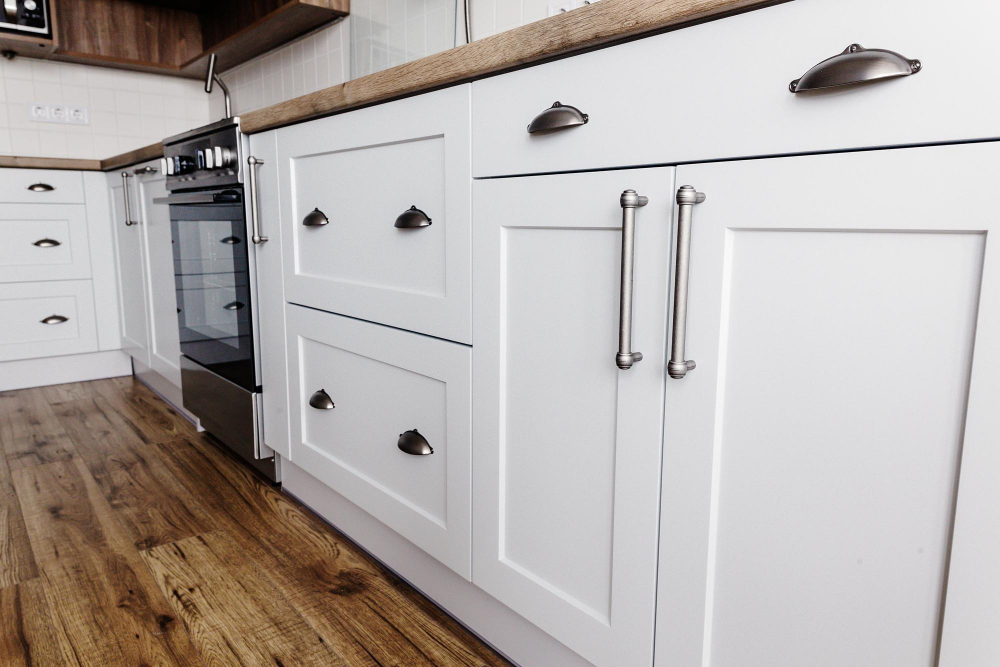
However, cabinet hardware can make a significant difference in the overall look and feel of your kitchen. If you’re looking to match new cabinets with your existing ones, take note of the type and style of hardware used on your current cabinetry.
Consider factors such as knob or pull size, shape, finish color and material when selecting new cabinet handles or knobs for replacement. You may also want to consider updating all the handles in order to create a more cohesive look throughout the space.
If you’re unable to find an exact match for your current cabinet hardware but still want them all uniformed then consider replacing everything with something that complements both old & new cabinetry styles while keeping functionality intact.
Color Matching Techniques
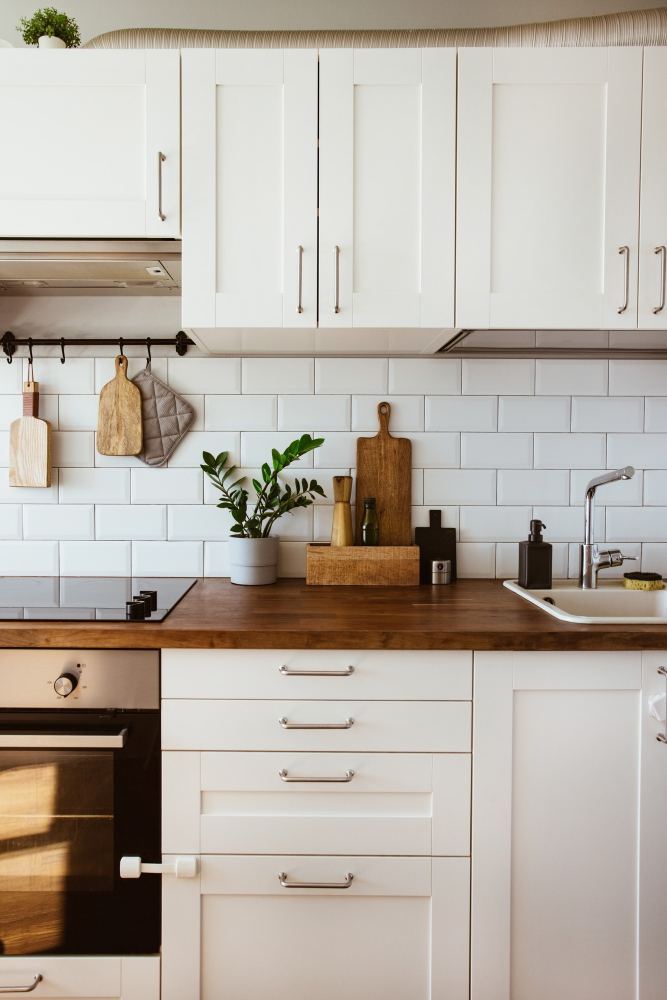
Even if you find a cabinet that matches your existing ones in terms of style and material, if the colors don’t match up perfectly, it can throw off the entire look of your kitchen.
One technique for color matching is to bring a sample door or drawer from one of your existing cabinets with you when shopping for new ones. This way, you can compare colors side by side and ensure that they match as closely as possible.
Another option is to take advantage of custom staining services offered by some cabinet suppliers. They may be able to create a custom stain that matches the exact shade and tone of your current cabinetry.
If all else fails, consider painting or refinishing all cabinets so they are uniform in color – this will give them an updated look while still maintaining consistency throughout the space.
Matching Woods and Veneers
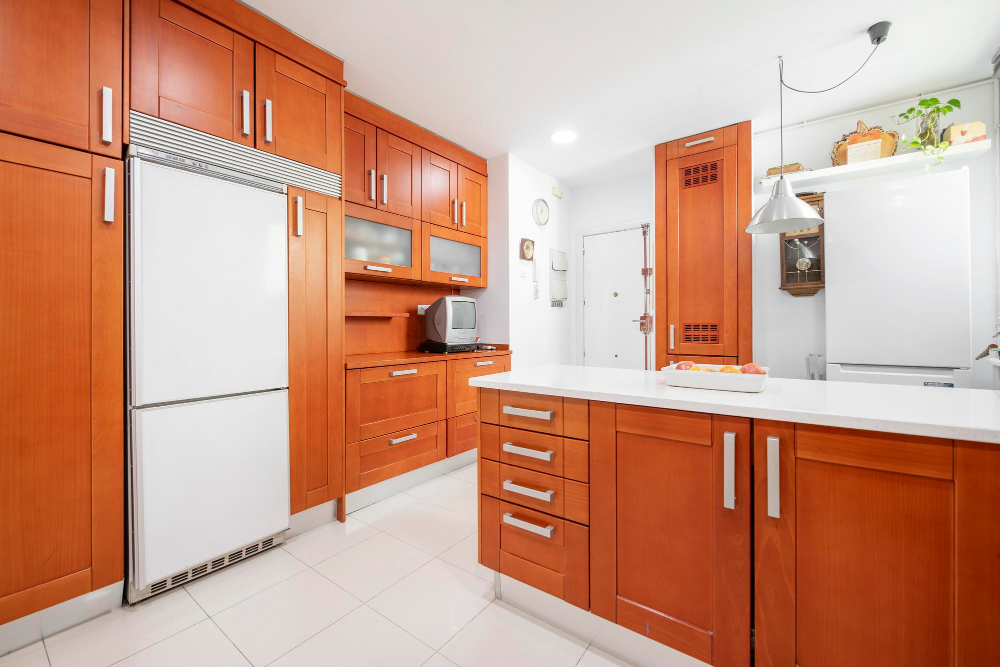
If you’re lucky enough to have solid wood cabinets, then it’s essential to find a supplier who can provide you with an exact match. However, if your existing cabinetry has a veneer finish, then things can get a little trickier.
When trying to match veneers, it’s crucial first to identify what type of wood was used in your current cabinetry. This information will help you determine which types of woods are compatible with each other and which ones aren’t.
If finding an exact match for your cabinet’s veneer isn’t possible or too expensive, consider using complementary woods instead. For example: pairing oak with maple or cherrywood could create beautiful contrast while still maintaining harmony between old and new elements in the kitchen design.
Remember that different finishes on similar-looking woods may not always be identical; therefore staining might be necessary for achieving perfect color matching results.
Choosing the Perfect Hardware
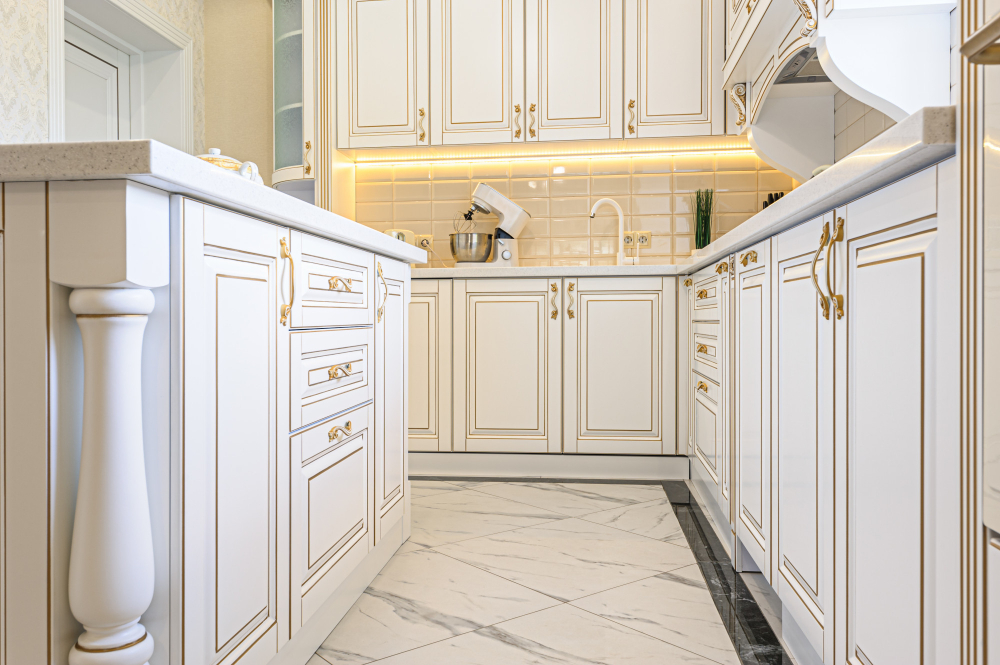
Hardware includes knobs, pulls, hinges and other decorative elements that add a finishing touch to your cabinetry. The key is to select hardware that complements your existing cabinets while also adding a fresh look.
One option is to choose new hardware in the same style as your old ones but with an updated finish or color. For example, if you have brass knobs on your current cabinets and want something more modern-looking, consider brushed nickel or matte black finishes instead.
Another approach is to mix and match different styles of hardware for an eclectic look. This works particularly well if you have open shelving or glass-fronted cabinet doors where each piece of hardware will be visible.
Ultimately, when selecting new cabinet handles and pulls for matching purposes; keep in mind their size relative to the size of drawers/cabinets they’ll be used on so they don’t overpower them visually.
Custom Vs. Stock Cabinets
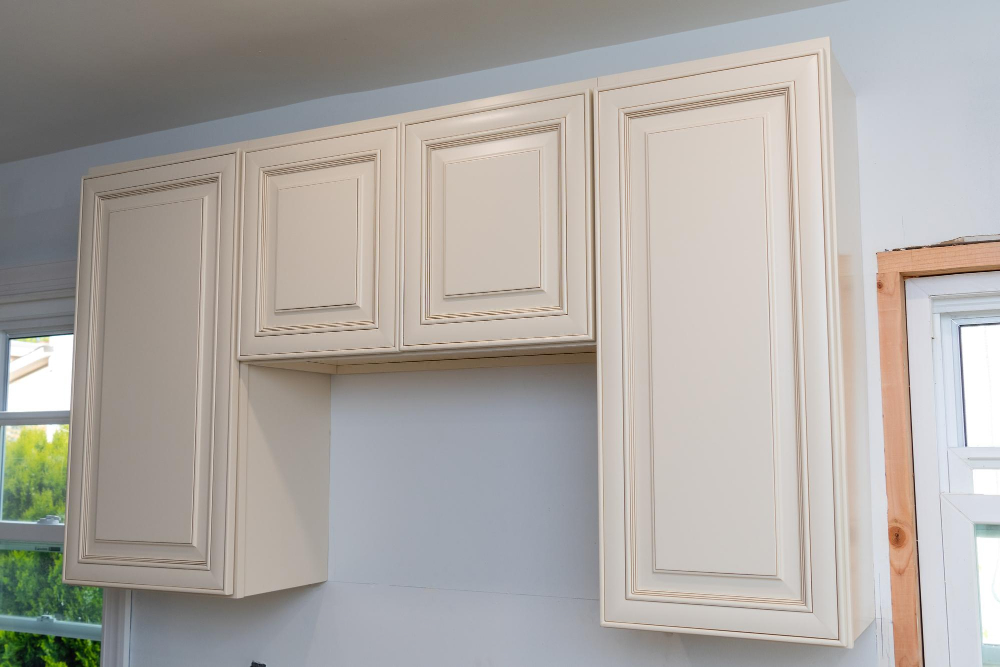
Custom cabinets are made-to-order and can be designed to match your existing cabinetry perfectly. However, they tend to be more expensive and take longer to install than stock cabinets.
Stock cabinets, on the other hand, are pre-made in standard sizes and finishes. While they may not match your existing cabinetry exactly, there is a wide range of styles available that can complement your current setup nicely.
Choosing between custom or stock depends on several factors such as budget constraints and timeline for installation. If you have the time and money for customization then go ahead with it but if you’re working within a tight budget or need quick installation then consider going with stock options.
Evaluating Budget Constraints

Before you start shopping for new cabinets or hiring a contractor, evaluate your finances and determine how much you’re willing to spend on the project. Keep in mind that custom cabinetry will likely cost more than stock options, but may provide better results if you have unique cabinet dimensions or specific design requirements.
If your budget is tight, consider refacing your existing cabinets instead of replacing them entirely. This process involves applying veneers or laminates over the existing cabinet boxes and replacing doors and drawer fronts with new ones that match the finish of the veneer.
Another way to save money is by incorporating open shelving into your kitchen design. Open shelves are an affordable alternative to traditional upper cabinetry and can create an airy feel in smaller kitchens while providing ample storage space for everyday items.
Finding a Reliable Supplier
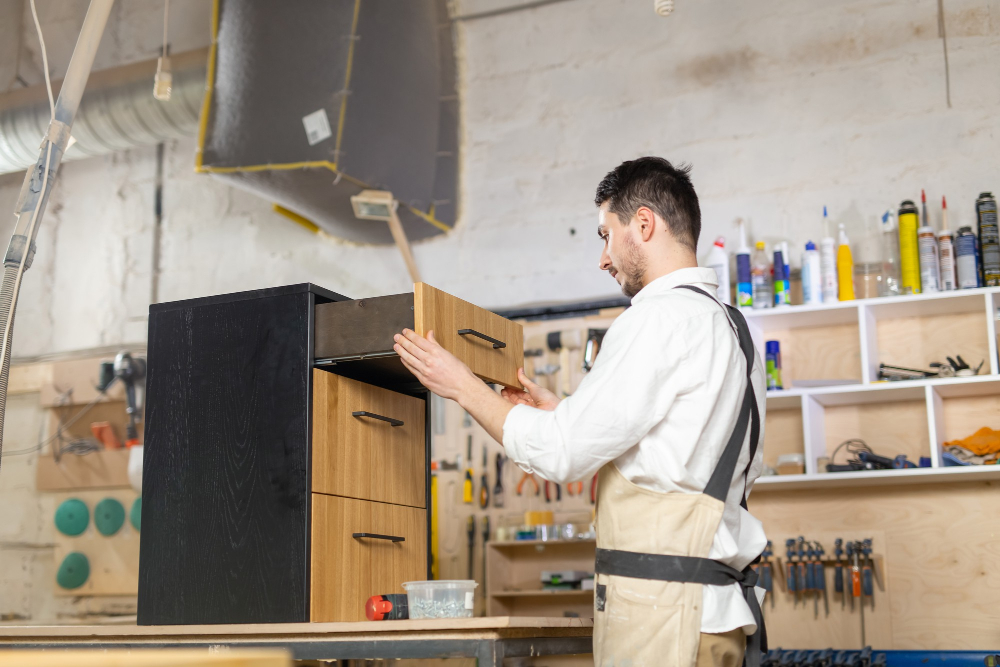
You want to make sure that the new cabinets you purchase match your existing ones as closely as possible in terms of style, color, and finish. One way to find a reputable supplier is by asking for recommendations from friends or family members who have recently completed a similar project.
Another option is to do some research online and read reviews from previous customers.
Once you’ve found potential suppliers, take the time to visit their showroom or website and examine their products carefully. Look for companies that offer customization options such as custom finishes or hardware choices so that you can achieve an exact match with your existing cabinetry.
It’s also important to consider factors such as pricing, delivery timescales and installation services when choosing a supplier. Don’t be afraid of negotiating prices if necessary but remember not always the cheapest option will provide quality workmanship.
Installation Tips
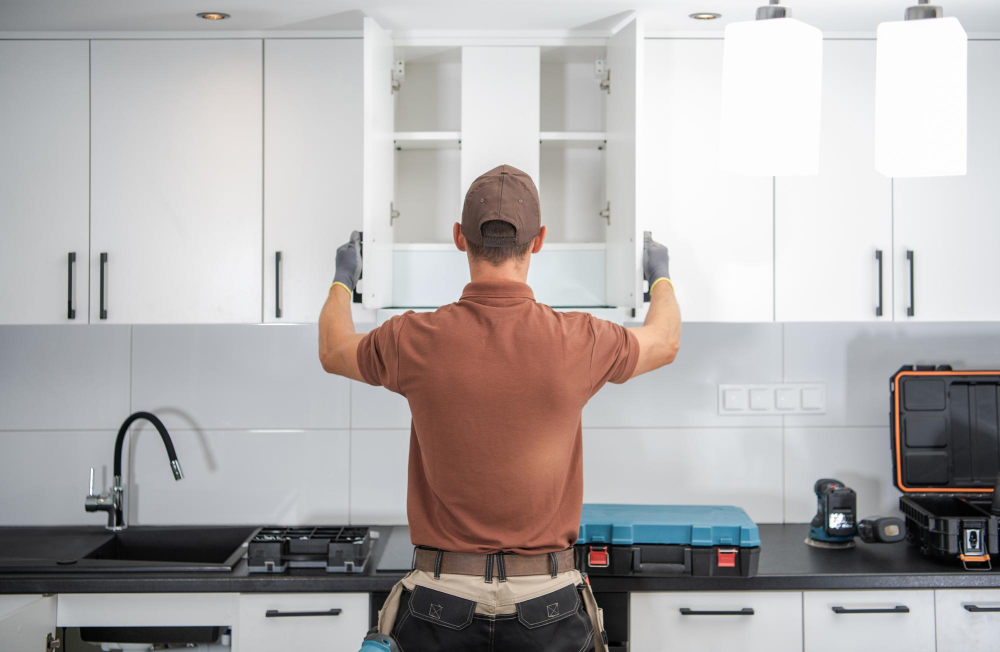
Installing new cabinets can be a challenging task, especially if you’re not experienced in DIY projects. If you’re unsure about installing them yourself, it’s best to hire a professional installer who has experience with matching existing cabinetry.
If you decide to install the cabinets yourself, make sure that they are level and plumb before securing them in place. Use shims as needed to ensure that each cabinet is perfectly level and flush with adjacent units.
Another important tip is to use screws instead of nails when attaching the cabinets together or mounting them on walls. Screws provide better support and stability than nails do over time.
Take care when drilling holes for hardware such as handles or knobs so that they align perfectly with those on your existing cabinetry.
Tips for Blending New and Old Cabinets
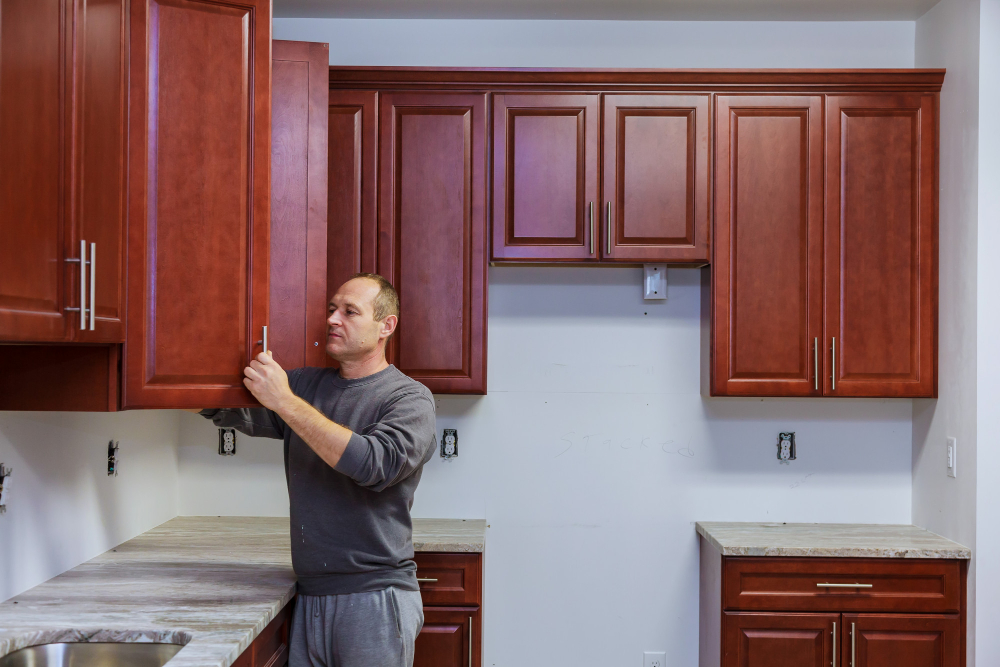
Here are some tips for achieving a cohesive look:.
1. Choose complementary colors: If your existing cabinets have a warm tone, consider adding new ones in a similar shade or color family.
2. Mix up the heights: Varying cabinet heights can add visual interest and help break up any monotony in your kitchen design.
3. Use open shelving: Open shelves can be an excellent way to introduce new cabinetry without disrupting the flow of your existing setup.
4. Add mouldings: Mouldings can be used as accents on both old and new cabinets to create continuity between different styles or finishes.
5. Consider customizing hardware: Swapping out hardware on all of your cabinetry is one way to make everything feel more cohesive while still introducing something fresh and modern into the mix.
Working With Cabinet Refacing
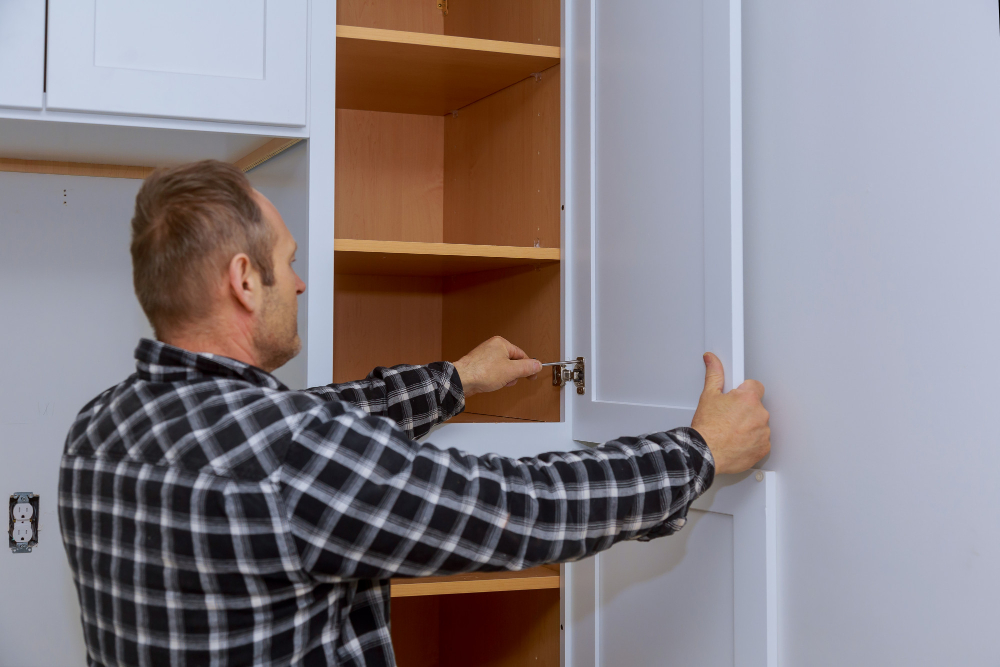
Refacing involves replacing the doors and drawer fronts while keeping the original cabinet boxes intact. This is a cost-effective way to update your kitchen without having to replace all of your cabinetry.
When working with cabinet refacing, it’s important to choose materials that match or complement your existing cabinets. You can opt for wood veneers or laminates that mimic natural wood grains and finishes.
It’s also essential to select hardware that matches both old and new components.
One advantage of using this technique is that you can easily blend new colors with old ones by choosing complementary shades for door panels, drawers, and other elements such as countertops or backsplashes.
Cabinet refacing allows you to keep some of the original character of your kitchen while giving it an updated look at an affordable price point.
Techniques for Aging and Distressing
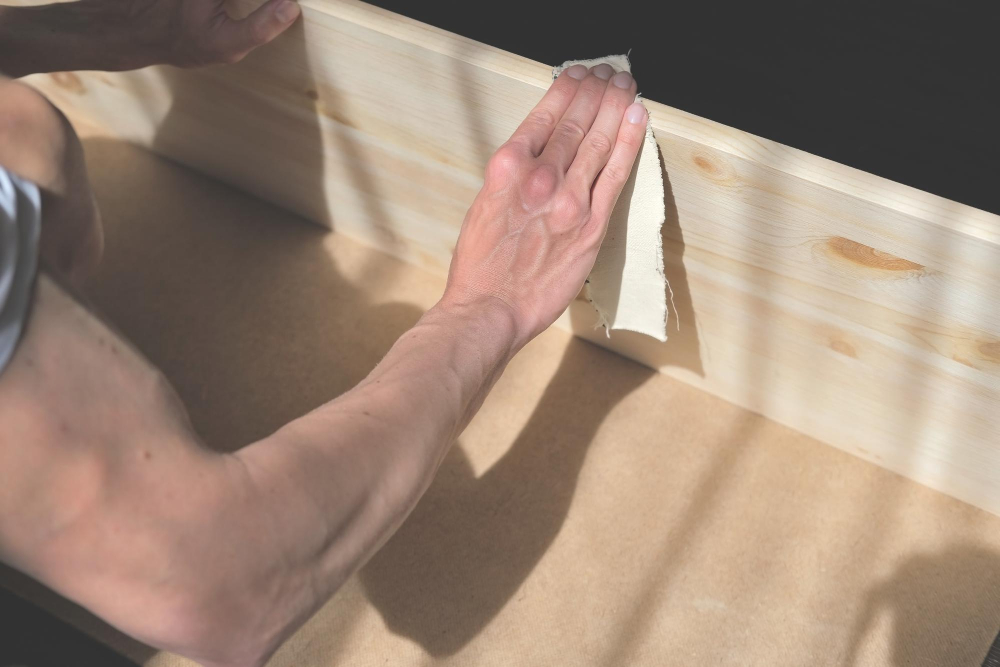
These methods involve creating intentional wear and tear on the new cabinets to make them look like they’ve been around for years. Some popular techniques include sanding down edges, adding dents with a hammer or chain, applying multiple layers of paint in different colors before sanding it off in certain areas to reveal the base color underneath.
When using these techniques, it’s important not to go overboard as too much distressing can make your kitchen look shabby rather than chic. A good rule of thumb is less is more – start small and build up gradually until you achieve the desired effect.
Another option for achieving an aged look without going through all the trouble yourself is purchasing pre-distressed cabinetry from suppliers who specialize in this style. This way you get all the benefits of an antique-looking cabinet without having to put any elbow grease into it yourself.
Incorporating Open Shelving
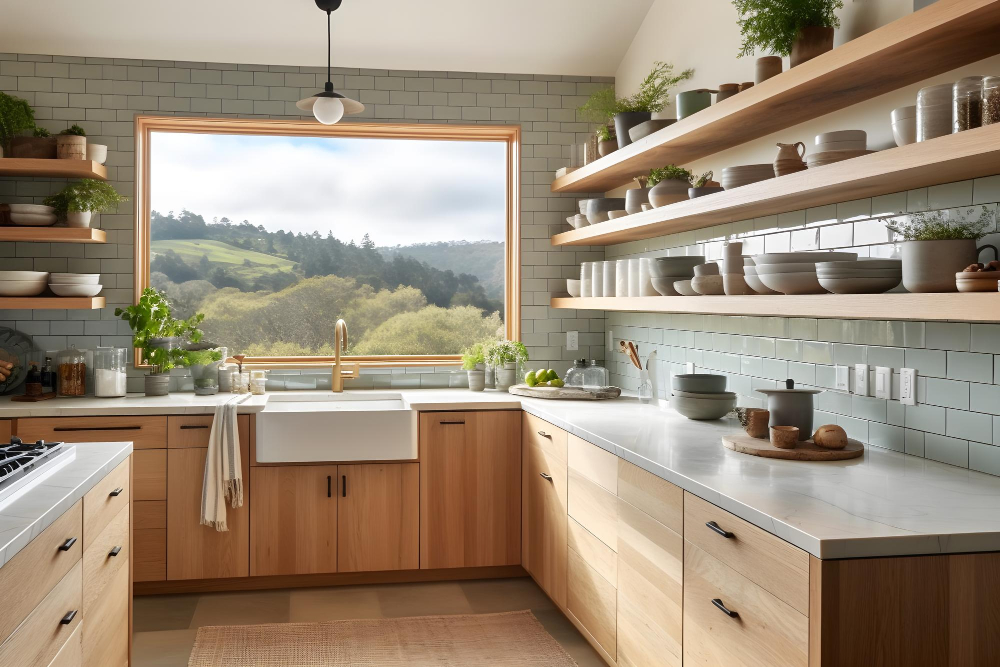
Open shelves can be used to display your favorite dishes, cookbooks, or even potted herbs for a touch of greenery in your kitchen. When incorporating open shelving into an existing cabinet setup, it’s important to consider the overall aesthetic you’re going for.
If you have modern cabinets with clean lines and minimal hardware, opt for floating shelves made from sleek materials like glass or metal. For more traditional cabinets with ornate details and warm wood tones, wooden shelves will blend seamlessly while adding warmth and texture.
When installing open shelving alongside existing cabinetry, make sure that they are level with each other so that they appear cohesive rather than disjointed. You may also want to consider painting or staining the new shelves in a color that complements your current cabinets’ finish.
Using Mouldings to Match
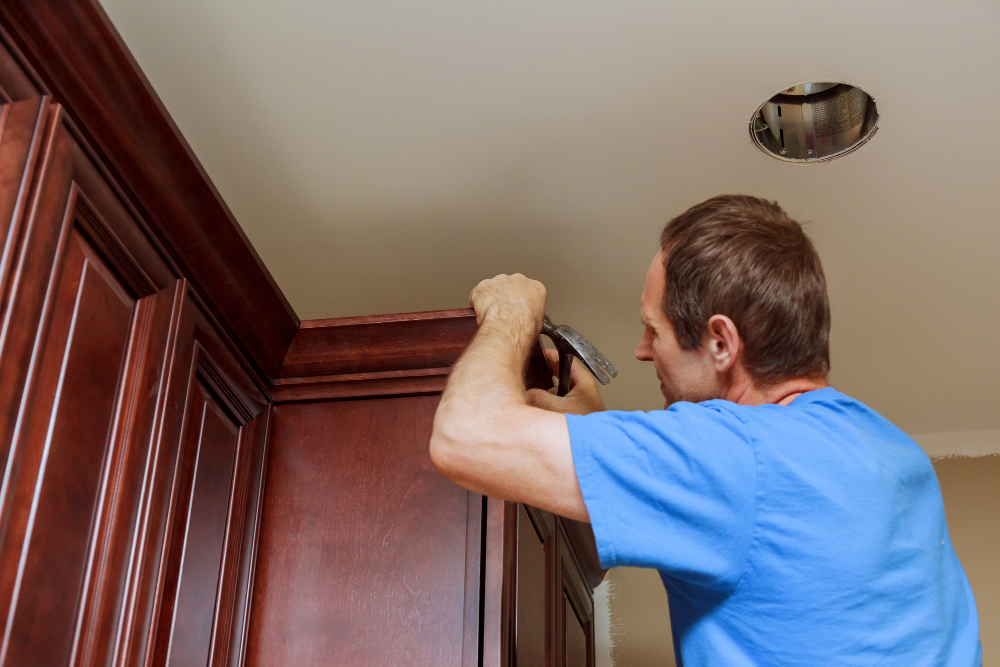
Mouldings can be used to create a seamless transition between old and new cabinetry by adding decorative elements that tie everything together. For example, if your existing cabinets have crown moulding at the top, you can add matching crown moulding to the new cabinets so that they blend in seamlessly.
Mouldings come in various styles and sizes, so it’s essential first to identify what type of trim is on your current cabinetry before selecting any additional pieces. Once you’ve determined the style of molding used on your existing cabinet doors or drawers fronts (if any), look for similar options when shopping for new ones.
Using moldings is an excellent option if you want an affordable solution that doesn’t require replacing all of your kitchen cabinets but still gives them a fresh look. It’s also perfect if there are only minor differences between old and new cabinetry since moldings will help mask those discrepancies while creating visual interest throughout the space.
Blending Cabinets With Appliances
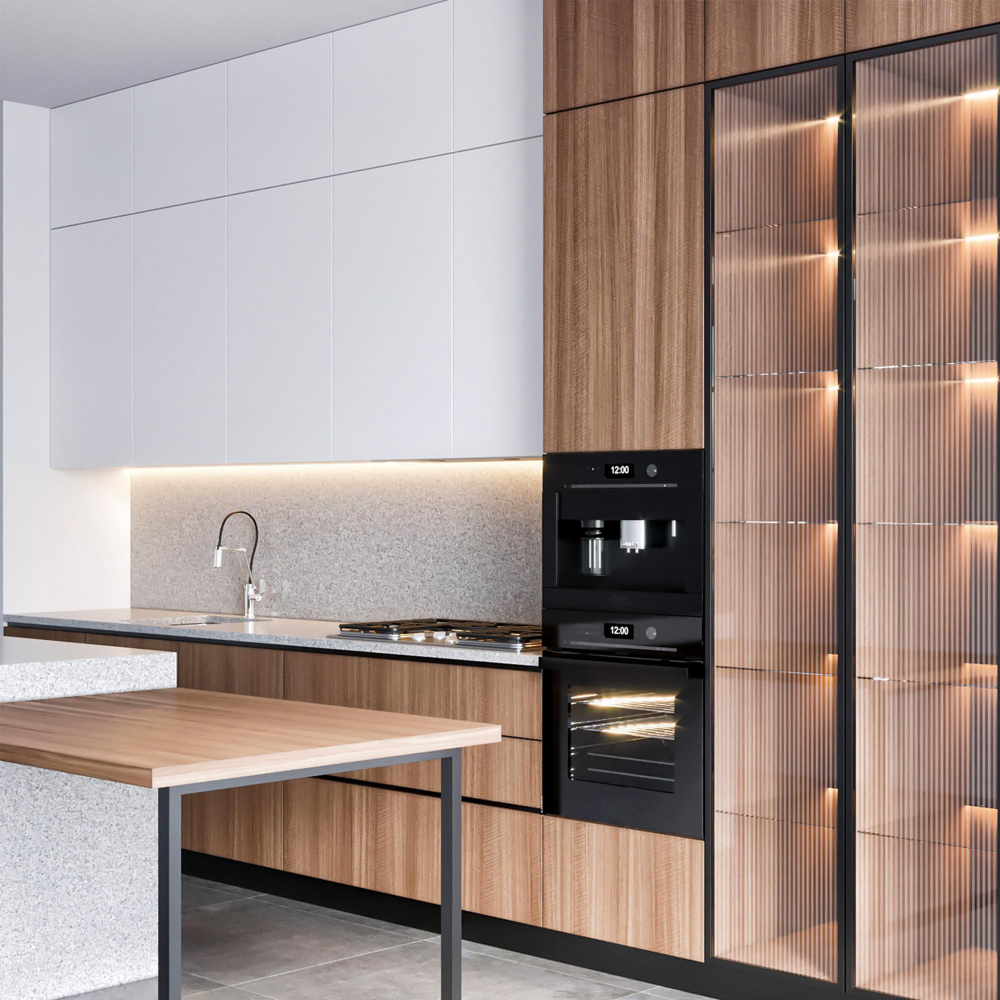
If you have stainless steel appliances, consider pairing them with darker wood cabinets or painted cabinetry in shades of gray or black. For white appliances, opt for lighter colored cabinetry such as natural oak or maple.
If you’re looking to create a more seamless look between your cabinets and appliances, consider investing in custom paneling that matches the finish on your refrigerator and dishwasher. This technique allows these large items to blend seamlessly into the surrounding cabinetry.
Another option is to use contrasting colors between the appliance and cabinet finishes for added visual interest. For example, if you have dark wood cabinets but want stainless steel accents throughout the kitchen, try incorporating brushed nickel hardware on all doors and drawers.
Creating a Cohesive Design

One way to do this is by incorporating complementary colors and finishes throughout your kitchen. For example, if you have dark wood cabinets with brushed nickel hardware, consider adding light-colored countertops or backsplash tiles to create contrast.
Another way to achieve cohesion is through repetition of design elements. If your existing cabinetry has decorative mouldings or trim pieces, try incorporating similar details in the new additions for a seamless look.
Don’t forget about lighting! Properly placed lighting can help tie together different cabinet styles and finishes while also highlighting their unique features.
By following these tips for creating a cohesive design in your kitchen space, you’ll be able to seamlessly blend old and new cabinetry for an updated yet timeless look that will leave everyone impressed.
FAQ
Can old cabinets be matched?
Old cabinets can be matched through a custom millwork shop, but it may be an expensive process, and replacing all the doors on the cabinet could be a more cost-effective option.
How do you match old cabinets with new cabinets?
To match old cabinets with new cabinets, coordinate your color palette by applying veneer or faux finish with glazes to the new cabinets to emulate the same wood grain and color as the old cabinets or hire a professional painter to achieve this effect, while considering varied colors for an eclectic, warm kitchen look.
How do I identify my kitchen cabinets?
To identify your kitchen cabinets, look for a sticker on the back of the sink door or cabinet side wall with a code or cabinetry name, common in brands belonging to the Kitchen Cabinet Manufacturers Association (KCMA).
What is the best approach to finding a color match for my existing kitchen cabinets?
The best approach to finding a color match for your existing kitchen cabinets is to take a cabinet door or drawer front to a paint specialist who can use a spectrophotometer to create an accurate paint match.
Are there specific materials or finishes to consider when trying to match new cabinets with old ones?
To match new cabinets with old ones, consider using similar materials and finishes as the existing cabinets.
How can I ensure a seamless transition between old and new cabinets to achieve a consistent, cohesive appearance?
To ensure a seamless transition between old and new cabinets for a consistent, cohesive appearance, consider matching their styles, colors, and hardware.
